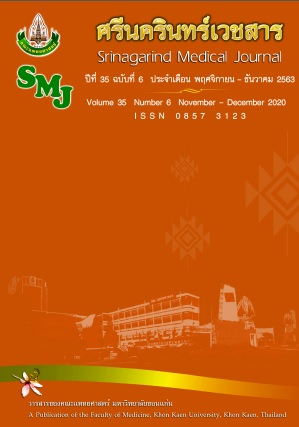Continuous Quality Improvement of Clinical Practice Guideline for Management of Patients Undergoing Percutaneous Nephrolithotomy Under General Anesthesia in Srinagarind Hospital
Keywords:
Percutaneous nephrolithotomy; PCNL; PaO2/FiO2 ratio; Endrotrachial tube; AgitateAbstract
Background and Objective: Percutaneous nephrolithotomy (PCNL) is a minimal invasive surgery for treatment of renal calculi. It may cause pleural cavity injury, i.e., pneumothorax, hydrothorax, or hemothorax (P/H/H), which mostly occurs in supracostal access of trocar puncture. The previous practice guideline requires that, for safety, endotracheal tube must be retained at the end of surgery in all patients undergoing PCNL with supracostal access leading to patient discomfort and agitation. They were extubated after pleural cavity injury was assessed using portable CXR at PACU. To reduce patient discomfort, we improved the guideline using PaO2/FiO2 (P/F) ratio ≤ 300 mmHg as criteria to retain endotracheal tube in these patients. The objective of this study was to evaluate the efficacy of the new guideline.
Methods: This was a prospective, descriptive study. We included all adults undergoing elective PCNL at Srinagarind hospital, Khon Kaen university between July 2017 and November 2018. We identified the incidence of endotracheal tube retaining and pleural cavity injury.
Results: Forty-seven patients were included. There were 20 cases (42.6%) with supracostal access. Among supracostal patients, there were 9 cases (45%) with P/F ratio ≤ 300 mmHg who required endotracheal tube retaining with 2 cases (4.3%) complicated with hydrothorax and 3 cases (6.4%) with sepsis.
Conclusions: The improved guideline using P/F ratio ≤ 300 mmHg as criteria to retain endotracheal tube in patients undergoing PCNL with supracostal access can reduce incidence of endotracheal tube retaining from 100% to 45% without complication. The incidences of pleural cavity injury and sepsis were 4.3% and 6.4%.
References
2. Mousavi-Bahar SH, Mehrabi S, Moslemi MK. The safety and efficacy of PCNL with supracostal approach in the treatment of renal stones. Int Urol Nephrol 2011; 43: 983-987.
3. วิลาวัลย สมดี, เทพกรสาธิตการมณี, กชกรพลาชีวะ, วินิตาจีรา ระรื่นศักดิ์, สุธันนีสิมะจารึก, วิริยาถิ่นชีลอง, และคณะ. การเกิด pneumothorax, hydrothorax หรือhemothoraxระหว่างการให้ยาระงับความรู้สึกแบบทั่วไปในผู้ป่วยที่ได้รับการผ่าตัดแบบเจาะผ่านผิวหนังเพื่อนำนิ่วออกจากไตในโรงพยาบาลศรีนครินทร์. ศรีนครินทร์เวชสาร 2556; 28: 178-183.
4. Kim HC, Kim E, Jeon YT, Hwang JW, Lim YJ, Seo JH, et al. Postanaesthetic emergence agitation in adult patients after general anaesthesia for urological surgery. J Int Med Res 2015; 43: 226-235.
5. วิลาวัลย สมดี, เทพกร สาธิตการมณี, สิริรัตน์ ตรีพุทธรัตน์, ขจิตร์ พาชีรัตน์, กชกร พลาชีวะ, สุธันนี สิมะจารึก, และคณะ. การประเมินแนวปฏิบัติสำหรับภาวะ pneumothorax, hydrothorax หรือ hemothorax ในผู้ป่วยที่ได้รับการผ่าตัดแบบเจาะผ่านผิวหนังเพื่อนำนิ่วออกจากไตในโรงพยาบาลศรีนครินทร์. ศรีนครินทร์เวชสาร 2558; 30: 333-338.
6. Bilan N, Dastranji A, Ghalehgolab Behbahani A. Comparison of the spo2/fio2 ratio and the pao2/fio2 ratio in patients with acute lung injury or acute respiratory distress syndrome. J Cardiovasc Thorac Res 2015; 7: 28-31.
7. He Z, Tang F, Lu Z, He Y, Wei G, Zhong F, et al. Comparison of Supracostal and Infracostal Access For Percutaneous Nephrolithotomy: A Systematic Review and Meta-Analysis. Urol J 2019; 16: 107-114.
8. Bansal SS, Pawar PW, Sawant AS, Tamhankar AS, Patil SR, Kasat GV. Predictive factors for fever and sepsis following percutaneous nephrolithotomy: A review of 580 patients. Urol Ann 2017; 9: 230-233.
9. Sourial MW, Francois N, Box GN, Knudsen BE. Supracostal access tubeless percutaneous nephrolithotomy: minimizing complications. World J Urol 2019; 37: 1429-1433.




